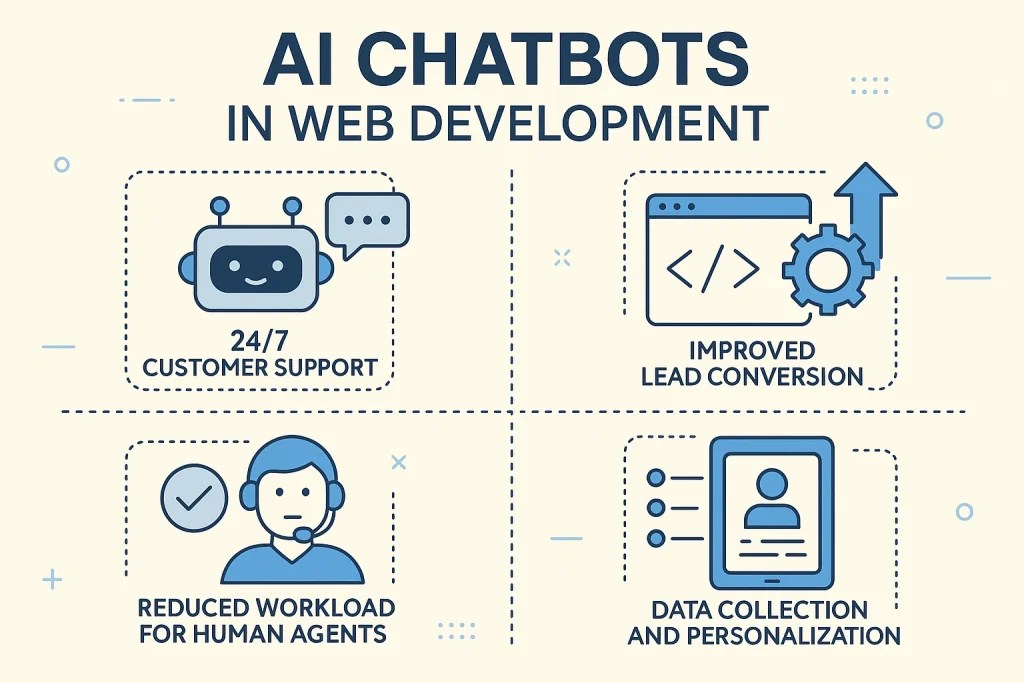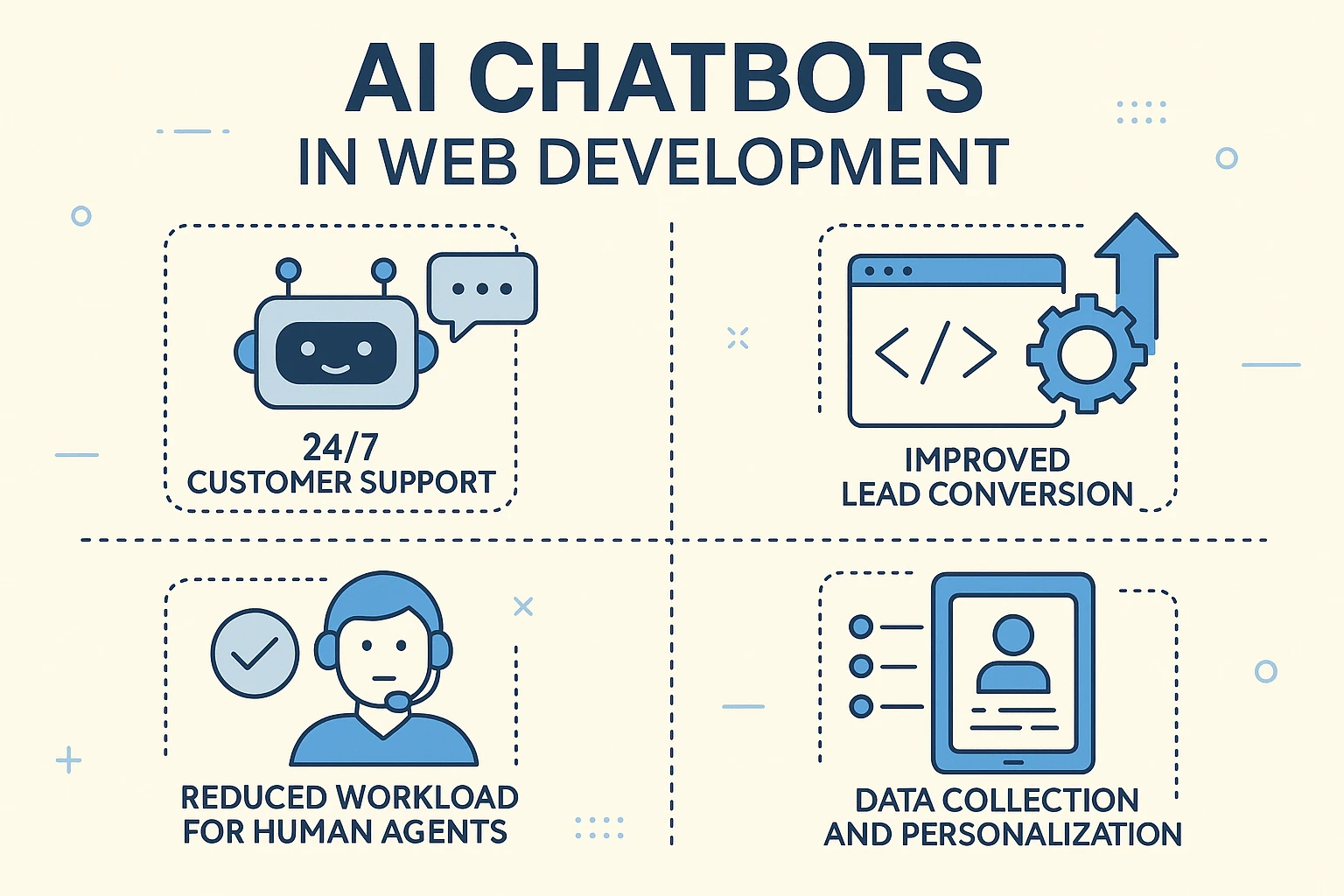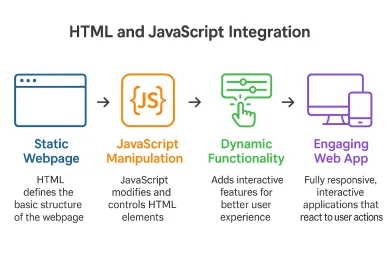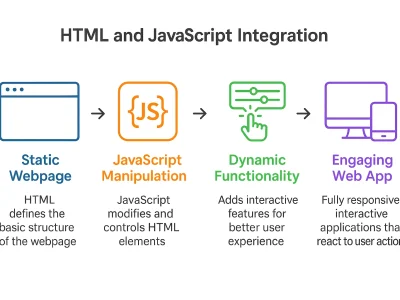Introduction
Imagine visiting a website and having a virtual assistant instantly respond to your queries with human-like accuracy, enhancing your overall user experience. That’s the power of Artificial Intelligence chatbots, transforming the landscape of web development. Fueled by AI and Natural Language Processing (NLP), chatbots enable real-time, personalized communication that keeps users engaged. The global chatbot market is projected to grow at a 23.3% CAGR by 2030, driven by its potential to enhance user interaction and reduce operational costs by nearly 30%.
So, why are chatbots becoming so popular? AI chatbots offer 24/7 user support while streamlining digital experiences. Mastering chatbot integration and prompt engineering is becoming essential for India’s emerging developers. Prompt Engineering—crafting precise inputs for accurate chatbot responses—is a key skill taught in our AI Tools course. If you’re aiming to build responsive, user-focused websites, this blog will help you understand the impact of AI chatbots and guide you through our practical learning path.
AI Chatbots and Websites
Overview of NLP, Machine Learning, and Automation
Ever wondered how chatbots understand you so well? They rely on Natural Language Processing (NLP), Machine Learning, and Automation to mimic human conversations. NLP helps chatbots analyze and understand user input, interpret intent, and respond appropriately—all in milliseconds. Meanwhile, machine learning allows these systems to evolve by learning from past interactions. Automation enables bots to handle repetitive queries without requiring human intervention.
Frontend and Backend Integration Basics
Chatbot integration involves a cohesive interaction between the frontend and backend. On the frontend, technologies like JavaScript or React.js create intuitive chat interfaces and handle live updates using WebSocket or AJAX. The backend—developed using Node.js or Python frameworks like Flask/Django—handles API requests to AI models, processes input, and generates relevant responses. This client-server architecture ensures responsiveness and scalability.
Common Platforms: Dialogflow, ChatGPT API, Microsoft Bot Framework
Popular platforms simplify chatbot creation. Dialogflow provides pre-trained NLP models for quick deployment. ChatGPT API, when used with effective prompt engineering, delivers highly contextual replies. Microsoft Bot Framework caters to enterprise-grade solutions. If you’re eager to master these, our AI Tools course offers expert mentorship to help you develop efficient and intelligent web-based chatbot systems.

Advantages of Using AI Chatbots
24/7 Customer Support
AI chatbots offer uninterrupted support, promptly answering customer queries, reducing bounce rates, and keeping users engaged. This around-the-clock availability makes them a smart investment in today’s fast-paced digital ecosystem.
Improved Lead Conversion
With instant responses and guided navigation, chatbots boost lead conversion. Studies suggest that well-integrated chatbots can increase conversion rates by up to 20%, helping businesses drive more sales.
Reduced Workload for Human Agents
By managing repetitive inquiries, chatbots free up human agents for higher-priority tasks, improving overall efficiency and reducing operational costs.
Data Collection and Personalization
AI chatbots can collect and analyze user data to provide personalized experiences—like recommending relevant products or content. With multi-language capabilities, they cater to diverse audiences, enabling businesses to scale effectively.
Potential Drawbacks and Limitations
Miscommunication or Lack of Context
When NLP fails to grasp user intent, responses may feel off-target. This issue highlights the need for refined prompt engineering to increase response accuracy.
Dependency on Third-Party Tools
Reliance on platforms like Dialogflow or ChatGPT API may lead to subscription costs and limited customization, locking developers into specific ecosystems.
Setup and Maintenance Costs
Initial development, hosting, and regular updates can be costly—especially for startups. Budget planning should consider these factors to avoid overspending.
Not Ideal for All Industries
In sectors such as healthcare or legal services, where empathy and human judgment are vital, chatbots may not suffice. Despite their capabilities, they can still feel impersonal in such contexts.
Use Cases of AI Chatbots in Modern Websites
SaaS: Customer Onboarding, Troubleshooting
Chatbots guide new users through onboarding, troubleshoot common issues, and reduce support ticket volumes—enhancing user satisfaction in SaaS platforms.
Education: Course Recommendations, Query Handling
In edtech, chatbots recommend courses and answer questions, making learning platforms more interactive and supportive.
Banking/Finance: Account Queries, Transaction Tracking, Fraud Alerts
AI bots in banking handle account-related questions, track transactions, and even flag potential fraud—ensuring security and convenience.
E-commerce: Product Guidance, Cart Reminders
E-commerce bots suggest products based on user preferences and send cart reminders—reducing cart abandonment and increasing conversions.
Are Chatbots Worth It? A Cost-Benefit Analysis
ROI Considerations
Chatbots significantly enhance UX, with over 65% of customers reporting higher satisfaction. Though initial development costs can be high, the long-term ROI justifies the investment.
Rule-Based vs. AI-Driven Bots
Rule-based bots are cheaper and suit basic tasks. AI-driven bots handle complex queries and offer personalized responses, albeit at higher costs.
Budget and Business Size Impact
While small businesses may lean toward affordable rule-based bots, larger enterprises often invest in AI-based solutions for scalability and richer user engagement.
Best Tools and Platforms for Chatbot Development
-
ChatGPT API: Offers advanced NLP capabilities with prompt customization.
-
Botpress: An open-source tool for custom bot development.
-
Landbot: Ideal for non-coders—drag-and-drop simplicity.
-
Tidio: Perfect for e-commerce, blending AI with live chat functionality.
Integration with React, WordPress, or No-Code Tools
These tools integrate seamlessly with frameworks like React.js, WordPress, and no-code builders. React developers can use ChatGPT APIs for dynamic interfaces, while WordPress users can easily install plugins like Tidio. Landbot serves non-technical users, and Botpress connects via APIs for advanced custom setups.
Real-World Examples
-
Bank of America’s chatbot “Erica” handles 98 million queries annually and increases customer satisfaction by 20%.
-
Sephora’s chatbot provides tailored product suggestions and cut response times by 40%, boosting conversions by 15%.
-
Duolingo’s chatbot enhances language learning through interactive conversations, increasing engagement by over 40%.
Future of AI Chatbots in Web Development
Trends: Multimodal Bots, Voice, and Emotion Recognition
Next-gen bots will blend text, voice, and visual content. Voice-integrated bots already appeal to over 60% of users. Emotion-aware bots will personalize responses by gauging user sentiments, further improving engagement.
AI Copilots and Intelligent Agents
AI copilots assist developers in integrating bots efficiently, while intelligent agents manage tasks autonomously (e.g., bookings, troubleshooting). By 2026, over 30% of businesses are expected to use AI agents to enhance customer service.
Conclusion
AI chatbots are reshaping customer communication and web development. They provide 24/7 support, boost conversions, and personalize experiences using NLP and machine learning. By increasing user retention and offering multilingual support, they make websites more accessible and efficient.
That said, developers must consider challenges like integration costs, tool dependency, and suitability for sensitive industries. A clear analysis of pros and cons will help businesses make the right decision.
So, are chatbots worth it? Absolutely—especially for industries like education, e-commerce, and SaaS, where automation drives results. Ready to integrate chatbots into your next project? Join Tutedude’s AI Tools Course or connect with us for expert guidance. Don’t forget to bookmark this blog or share it with fellow developers!





